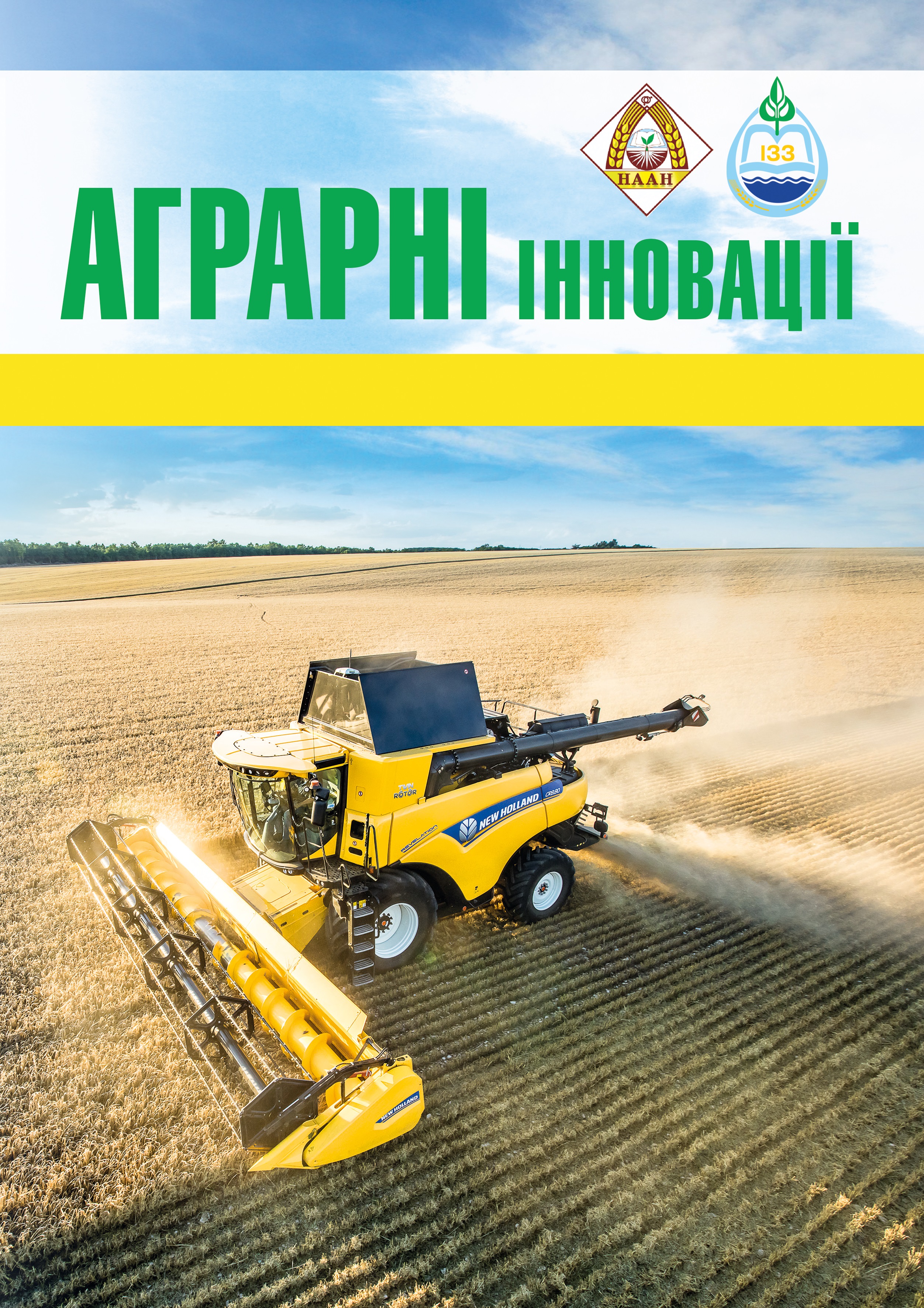Influence of preparations of chemical and biological origin on the field germination and productivity of summer potatoes planted with freshly picked tubers
Abstract
The goal of the research was to determine the possibility of reducing the chemical load on the environment when using summer planting with freshly picked tubers. Methods. Field studies were carried out in accordance with the requirements of research methods and methodological recommendations for conducting research with potatoes on irrigated lands of the Institute of irrigated agriculture of the National Academy of Sciences in the area of operation of the Ingulets irrigation system. Mathematical processing of experimental data was carried out according to generally accepted methods. The study compared the effect of chemical treatment of tubers after drying of the 4-component solution of stimulants (1% thiourea, 1% potassium permanganate, 0.002% succinic acid, 0.0005% gibberellin) on germination, plant development and planting productivity. Drugs Gaupsin, Trichodermin, Urea K-6 were studied. These biologics are not harmful to humans, warmblooded animals, insects, fish, and do not accumulate in plants. Agricultural technology in the experiment, in addition to the studied factors, is generally accepted for irrigated lands in the south of Ukraine. Repetition – four times. Results. The effect of any drug, both in its pure form and in combination with other drugs, on the intensity of seedling formation was not revealed. The average yield values for three years of research indicate that none of the options for processing seed tubers provided a significant increase in plant productivity. The maximum average yield of tubers was provided by the option with additional treatment of tubers with Gaupsin biologics – 21.19 t/ha, which is only 1.58 % higher than the control (background). The productivity of the control variants was 20.86 and 20.72 t/ha. The minimum average yield was 18.86 t/ha, which is 2.0 T, or 9.59% lower than the control in the variant with additional treatment with Urea K-6. Conclusion. The level of potato yield in summer planting did not depend on the treatment of freshly picked tubers in summer planting with preparations of chemical and biological origin. On the only option with additional treatment of plants with the fungicidal biologics Gaupsin, the yield compared to the control was higher by 0.33 t/ha, or 1.6%, respectively, the profitability of production by 11.2%, and the conditional net profit by 4.35 thousand UAH/ton. The remaining options did not exceed the control.
References
2. Бречко Е., Конопацкая М., Жукова М. Картофель: защита при посадке. Белорусское сельское хозяйство. 2013. 4. С. 43–48.
3. Гайнатулина В.В., Макарова М.А. Химические и биологические фунгициды на защите картофеля от ризоктониоза. Дальневосточный аграрный вестник. 2018. 3(47). С. 7–12 DOI: 10.24411/1999-6837-2018-13051
4. Іутинська Г.О. Шляхи регулювання функцій мікробних угруповань ґрунту в аспекті біологізації землеробства і стійкого розвитку агроекосистем. Сільськогосподарська мікробіологія : зб. наук. пр. Чернігів : ЦНТЕІ. 2006. 3. С. 7–18
5. Колтунов В.А., Войцешина Н.І., Бородай В.В. та ін. Вплив обробки біопрепаратами на врожайність, товарність, структуру та збереженість бульб картоплі залежно від умов вирощування і строку садіння. Картоплярство України. 2012. № 1-2 (26-27). С. 35–43.
6. Маханько В.Л., Пискун Г.И., Турко С.А., Фицуро Д.Д. Основные элементы технологии выращивания экологически чистого картофеля. Москва : Земледелие и защита растений. 2017. 2. С. 36–39.
7. Методичні рекомендації щодо проведення досліджень з картоплею. Ін-т картоплярства. Київ : Аграрна наука, 2002. С. 62.
8. Наказ Міністерства аграрної політики та продовольства України 12 липня 2019 року № 384 «Про затвердження Методичних вимог у сфері насінництва щодо збереження сортових та посівних якостей насіннєвої картоплі». URL: https://zakon.rada.gov.ua/laws/show/en/z0829-19#n14 (дата звернення: 29.09.2020).
9. Патика В.П., Омельянець Т.Г. Екологічні основи застосування біологічних засобів захисту рослин як альтернативи хімічним пестицидам. Агроекологічний журнал. 2005. № 2. С. 21–24.
10. Arseneault T., Goyer C., Filion M. Biocontrol of potato common scab is associated with high Pseudomonas fluorescens LBUM223 populations and phenazine-1-carboxylic acid biosynthetic transcript accumulation in the potato geocaulosphere. Phytopathology. 2016. № 106(9). P. 963–70. doi: 10.1094/PHYTO-01-16-0019-R
11. Amelia Cirou, Stephanie Diallo, Caroline Kurt. Cirou Amelia Growth promotion of quorum – quenching bacteria in the rhizosphere of Solanum tuberosum. Environ. Microbiol. 2007. P. 1551–1522.
12. Sarah J. Coulthurst, Anne M. Barnard, George P.C. Salmond Coulthurst Sarah J. Regulation and biosynthesis of carbapenem antibiotics in bacteria. Nat. Rev. Microbiol. 2005. P. 343–353.
13. Larkin R. P., Honeycutt C. W., Griffin T. S., Olanya O. M., Halloran J. M., He Z. Effects of different potato cropping system approaches and water management on soilborne diseases and soil microbial communities. Phytopathology. 2011. № 101(1). P. 58–67. doi: 10.1094/PHYTO-04-10-0100
14. Lin C., Tsai C.H., Chen P.Y., Wu C.Y., Chang Y.L., Yang Y.L., et al. Biological control of potato common scab by Bacillus amyloliquefaciens Ba01. PLoS ONE. 2018. 13(4): e0196520. https://doi.org/10.1371/journal.pone.0196520
15. Mohammed T. Abbas Mervat, A. Hamza Hanan, H. Youssef Gehan, H. Yousse Mohamed Fayez, Mohamed Moniba, Nabil A. Hegazi. Bio-preparates support the productivity of potato plants grown under desert farming conditions of north Sinai: Five years of field trials Journal of Advanced Research. 2014. № 5(1). P. 41–48. DOI:10.1016/j.jare.2012.11.004
16. Han J. S., Cheng J. H., Yoon T. M., Song J., Rajkarnikar A., Kim W. G., et al. Biological control agent of common scab disease by antagonistic strain Bacillus sp. sunhua. J Appl Microbiol. 2005. № 99(1). Р. 213–21. doi: 10.1111/j.1365-2672.2005.02614.x
17. Hiltunen L.H., Ojanpera T., Kortemaa H., Richter E., Lehtonen M.J., Valkonen J.P. Interactions and biocontrol of pathogenic Streptomyces strains co-occurring in potato scab lesions. J Appl Microbiol. 2009. № 106(1). P. 199–212. doi: 10.1111/j.1365-2672.2008.03992.x
18. Wilson C., Ransom L., Pemberton B. The relative importance of seed borne inoculum to common scab disease of potato and the efficacy of seed tuber and soil treatments for disease control. J Phytopathol. 1999. № 147. P. 13–8.






